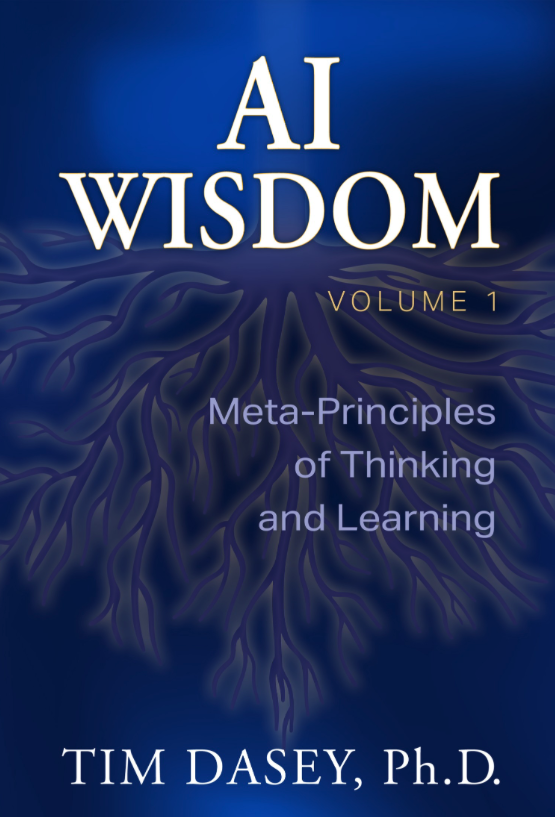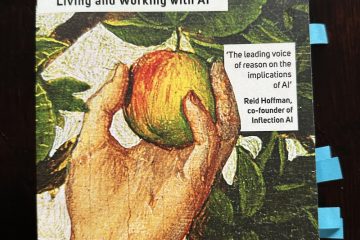In AI Wisdom: Volume 1 Meta-Principles of Thinking and Learning (2025), Tim Dasey, PhD, draws on his background in training neural networks and concern for education to explain some of the core principles that underpin both human and artificial intelligence (AI). The book is divided into two parts: Part 1 covers meta-cognition and Part 2 covers meta-learning and teaching. Dasey aims to show that the roots of AI are the meta-principles of thinking and learning, meaning that teaching about the essence of AI doesn’t necessarily need to even involve using AI or using a computer. I appreciate the viewpoint that people, particularly students coming through the system, should be able to gain durable knowledge and skills that will outlast any changes in AI models or technologies.
Explicit about AI Model Training
This is the first book I’ve read that explicitly states that you have permission to upload it into an AI large language model, but that you need to make sure that your account settings have model training turned off so that you’re not training the model on Dasey’s book. I suspect this is something we will be seeing more of in upcoming writing, and it would be valuable if people had an easy way to check their settings or to specifically exclude certain things. Other authors who are unaware of what’s happening in the AI space likely have no idea that their digitized book material is being uploaded into these systems so that readers can access the information in a different way.
Analogies and Visualizations
What I found particularly valuable about this book was Dasey’s ability to use analogies to communicate the concepts in AI. These help concretize what he’s talking about and make it more understandable, and I appreciate that they are often centered on an educational context. His description of neural networks and how they work in a distributed way, like humanity’s cultural knowledge, makes more sense than a lot of other explanations of AI I’ve come across. Dasey also uses hypothetical data plotted in graphs to illustrate how AI categorizes information and why it’s not going to be 100% accurate all of the time. It has to draw boundaries somewhere, and the visualizations help reinforce the points made. These explanations helped inform his discussion of different types of biases, too.
One of my favorite images was of neural networks as a stained-glass window, where the input is the pattern of light, the hidden layers and weights are the glass, and the output is the pattern of colored light that shows through at the end (24). I can see myself using this in the future for non-technical audiences.
Comparisons with the Mind
Dasey challenges the criticism that “AI ‘just’ analyzes patterns” as showing a misunderstanding about intelligence, because this is how natural intelligence works as well (22). To support his point, he mentions Daniel Kahneman’s book Thinking, Fast and Slow and how brains have a conscious and unconscious part, but the latter is where most action happens because the unconscious part is fast and constantly analyzing patterns (37). Although our minds are much less verbal than AI and its large language models, there are similarities in how our minds process information and how AI conducts pattern analysis.
AI as a Conceptual Creature
One of the most valuable insights in the book concerns Dasey’s discussion about how AI is a conceptual creature. He observes that decades of science fiction media have made us think of intelligent machines as being reliable when it comes to facts and being precise, but we can’t think of Generative AI in that way. It deals in concepts rather than facts.
Consider the concept of “chair.” Seems simple, right? Now try to define what counts as a chair and what doesn’t. Four legs and a seat leave out bar stools. If it’s just something to sit on, then floors and rocks enter the concept. And what about bean bags? … “Chair” is not a single thing. It isn’t a fact—it’s a concept, and concepts defy perfect definitions. (43)
Those of us familiar with the concept of the platonic ideal of forms will know the difficulty in defining even what seems obvious. Dasey explains how AI is built not to store lists of facts, “but rather a complex web of conceptual relationships from which fact-like behavior emerges approximately” (42). His examples made sense in fleshing out this idea and strike to the heart of how we can know something without necessarily knowing all of the facts related to it.
Changing Traditional Education
Dasey uses his understanding of AI and how it is and will impact society to call for changes in education systems that are often still built around precise metrics, age-based grouping, and separate subject areas. There is need for harder-to-measure skills like critical thinking and a system that encourages exploration and flexibility. One issue is that teachers may feel the need to know a lot about AI before trying to teach it. But teachers don’t need to be experts to introduce new topics or technologies, in the same way that physicians can explore new treatments and engineers can solve new problems. Mastery isn’t needed, Dasey writes, and in fact a lack of expertise allows space for students to take on more agency and gain a deeper understanding (97).
Each chapter of the book ends with key meta-principles and an example learning progression that shows how the principles could relate to different education levels (e.g. young children, high schoolers, college-age students). Dasey clearly wants to help educators understand the fundamental principles and frameworks that will serve them and their students no matter how AI develops in the coming years. This first of two books on AI balances some of the technical aspects of this technology with easy-to-grasp analogies and direct comparisons to education. It is a useful read for those of us who want to promote AI literacy at a foundational level across a wide range of contexts.
Thanks to Tim Dasey for providing me with a review copy of AI Wisdom: Volume 1 Meta-Principles of Thinking and Learning.
As an Amazon Associate I may earn from qualifying purchases if you choose to purchase products using affiliate links on this site.

